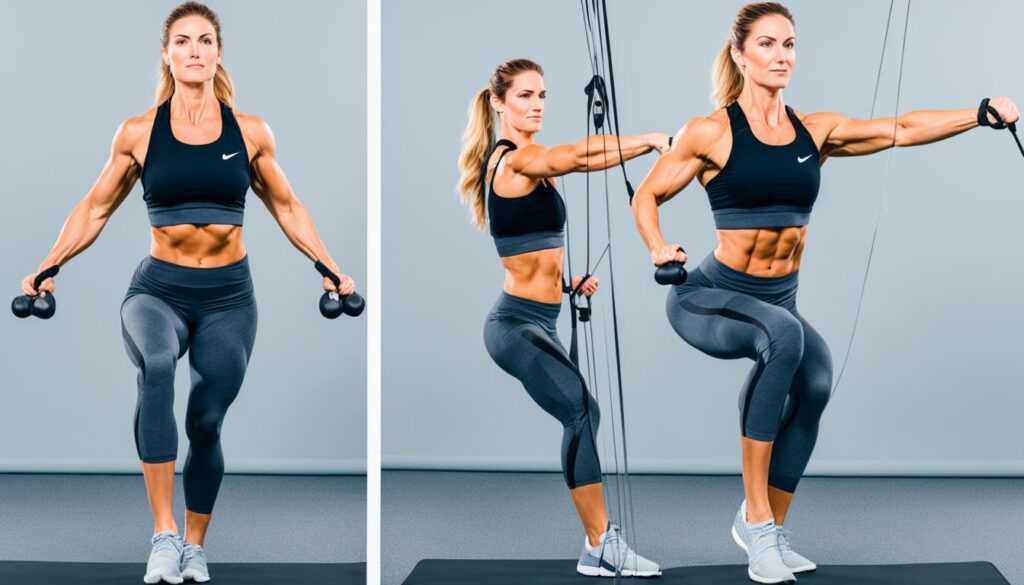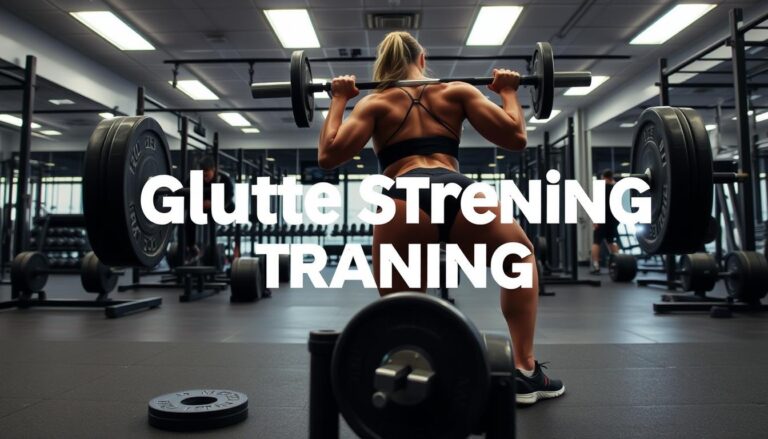As we navigate the diverse landscape of strength training, cable workouts emerge as a compelling choice for fitness enthusiasts. With their versatility and adaptability, cable fitness equipment offers a unique approach to muscle development and overall body conditioning. This introduction to cable workouts will delve into the benefits of resistance training using cables, highlighting how these tools can enhance your exercise routine in ways that traditional free weights might not.
Understanding the benefits of resistance training through cable machines requires an appreciation of their distinctive features. Unlike free weights, which rely on gravity, cable machines use a pulley system that allows for a consistent resistance through the entire range of motion. This capacity for maintaining muscle tension can contribute to more efficient strength gains and joint stability.
By exploring how cable fitness equipment can fit into your workout regimen, you’ll be better prepared to make educated decisions that align with your fitness goals. Whether you are a beginner seeking to establish a solid foundation or a seasoned athlete aiming to diversify your routines, cable workouts provide opportunities for growth and improvement.
Key Takeaways
- Cable workouts offer a versatile and adaptive approach to strength training.
- The pulley system in cable machines provides consistent resistance throughout exercises.
- Cable fitness equipment is suitable for both beginners and advanced users.
- Understanding the benefits of resistance training with cables can lead to more efficient muscle development.
- Integrating cable workouts can enhance overall body conditioning and joint stability.
What Are Cable Workouts?
Cable workouts are a dynamic form of strength training that utilizes a system of pulleys and weights to create constant resistance throughout the movement. Unlike traditional free weights, cable machines provide a unique challenge by enabling a continuous tension that keeps muscles engaged through the entire range of motion.
Definition and Overview
The definition of cable workouts revolves around exercises performed using cable machines, which are versatile pieces of gym equipment equipped with adjustable cables. These machines allow targeting of various muscle groups with a single piece of equipment, enabling diverse and comprehensive resistance training techniques that enhance overall fitness.
Benefits of Incorporating Cables
There are several advantages of cable machines, making them a popular choice among fitness enthusiasts:
- Muscle Endurance: Continuous tension increases muscle endurance and stamina.
- Range of Motion: Enables full range of motion, improving flexibility and muscle activation.
- Safety: Reduced risk of injury as the guided cables provide controlled resistance.
- Customization: Adjustable resistance levels suit all fitness levels, from beginners to advanced athletes.
The Essentials of Cable Machines
Cable machines, a cornerstone of modern gyms, offer a versatile approach to fitness training. When it comes to Cable Fitness Systems, understanding the various types and their functionalities is essential.
Types of Cable Machines
Cable Gym Equipment comes in multiple forms, each serving distinct purposes. Among the popular options are functional trainers, which allow for a wide range of movement patterns. Traditional cable crossover stations feature dual adjustable pulleys, ideal for both upper and lower body workouts. Standing row machines, on the other hand, are designed specifically to target the back muscles. Each of these machines offers unique benefits that cater to different fitness goals and necessities.
How Cable Machines Work
The underlying principles of Cable Fitness Systems revolve around the consistent resistance they provide through an adjustable pulley system. These pulleys, typically anchored at various heights, allow for continuous tension throughout the exercise motion. This setup is particularly beneficial as it adapts to the user’s strength, promoting natural movement patterns. The functionalities of cable machines also include smooth transitions between exercises, making them highly efficient for circuit training. The adaptability and consistent resistance of cable machines ensure that they remain a fundamental element of any comprehensive fitness regimen.
Cable Resistance Training Techniques

When it comes to Resistance Training Methods, the cable machine shines as a versatile and effective tool. The proper Cable Workout Form is crucial to maximize the benefits and minimize the risk of injury. Ensuring correct Exercise Execution is the foundation of any successful workout routine.
Controlled movements are pivotal in cable exercises. By maintaining slow and deliberate motions, one can ensure that the muscles are engaged throughout the entire range of motion. This method enhances muscle engagement and helps in isolating specific muscle groups. Understanding the muscle anatomy and the functionality of the cable machine components can significantly improve resistance training.
Creating effective resistance patterns is another critical aspect of cable workouts. This involves varying the weight and the angle of the cable to target different muscle fibers. Progressive overload is a key principle here – gradually increasing the resistance to continually challenge the muscles and promote growth. By adjusting the pulley height and incorporating various attachments, one can keep the workouts dynamic and tailored to specific goals.
For instance, when focusing on leg workouts, one can refer to comprehensive guides like this one that delves into optimal cable exercises for the lower body. Implementing a mixture of squats, lunges, and leg curls using the cable machine can ensure a well-rounded leg workout.
- Start with a basic Cable Workout Form, mastering the techniques with lighter weights.
- Gradually increase the resistance following the principle of progressive overload.
- Focus on controlled movements to enhance muscle engagement.
- Utilize different attachments and pulley heights to target various muscle groups.
Understanding and applying these Resistance Training Methods can elevate your fitness routine. Each Exercise Execution should be deliberate, ensuring you effectively engage and isolate the intended muscles. Incorporating these principles into your cable workouts will lead to improved strength, flexibility, and overall performance.
Popular Cable Machine Exercises
Mastering cable machine exercises can transform your upper body workouts, effectively targeting the chest, back, and other muscle groups. Here’s a closer look at three highly effective exercises: the Cable Chest Press, Cable Flyes, and Cable Rows.
Cable Chest Press
The Cable Chest Press is a staple in chest strengthening exercises. Begin by setting the cable pulleys at shoulder height. Stand with feet shoulder-width apart and grip the handles, ensuring elbows are bent at a 90-degree angle. Push the handles forward until your arms are fully extended, feeling the tension in your chest muscles. Slowly return to the starting position.
Cable Flyes
Another excellent addition to your upper body workouts is the Cable Flyes. Adjust the pulleys to chest height and stand in the center with a slight bend in your elbows. With handles in hand, bring your arms together in front of your chest, ensuring a gradual and controlled movement. This exercise specifically targets the pectoral muscles and enhances chest definition.
Cable Rows
Including Cable Rows in your routine boosts cable back exercises. Sit on the bench, feet placed firmly against the footrest, with the cable handle in both hands. Pull the handle towards your torso, squeezing your shoulder blades together. Lower the handle back slowly, maintaining control throughout the movement. This move significantly strengthens the back muscles, contributing to improved posture and overall upper body strength.
Cable Pulley System Workouts for All Levels
The versatility of a cable pulley system makes it an excellent option for individuals at any fitness level. Whether you’re just getting started with Beginner Fitness Plans or you’re looking to incorporate Advanced Exercise Techniques into your regimen, cable workouts offer scalable solutions to meet your needs. Below, I’ve organized specific routines to cater to beginners, intermediate users, and advanced athletes for effective and progressive resistance training.
Beginner Cable Workouts
If you’re new to resistance training, it’s essential to start with manageable exercises that lay a solid foundation. For those on Beginner Fitness Plans, the following exercises are ideal:
- Seated Cable Rows
- Standing Cable Bicep Curls
- Triceps Pushdown
- Squats with Cable Support
These exercises aim to enhance your form, build initial strength, and prepare your body for more complex movements.
Intermediate Cable Workouts
Once you feel confident with the basics, it’s time to step up your game. Intermediate Cable Workouts introduce more dynamic movements, incorporating Progression in Resistance Training:
- Single-arm Cable Rows
- Cable Chest Flyes
- Overhead Cable Tricep Extensions
- Split Stance Cable Press
These workouts facilitate the transition from basic to more challenging exercises, enhancing muscle coordination and strength.
Advanced Cable Workouts
For experienced trainees, Advanced Exercise Techniques make the most out of the cable pulley system. At this level, workouts are designed to push your limits:
- Cable Woodchoppers
- Low-to-High Cable Cross
- Cable Single-Leg Romanian Deadlifts
- Rotational Cable Press
These exercises demand greater stability, control, and strength, ensuring continuous improvement and peak physical condition.
For easy reference, here’s a breakdown:
| Level | Exercises |
|---|---|
| Beginner |
|
| Intermediate |
|
| Advanced |
|
Cable Exercise Variations for Different Muscle Groups

The versatility of cable machines is unparalleled, offering the ability to target virtually every muscle group effectively. By incorporating specific exercises, you can ensure a comprehensive workout that builds strength, enhances stability, and sculpts your physique.
Cable Leg Exercises
Lower Body Cable Training is a powerful way to engage your legs, targeting every muscle from the quadriceps to the glutes. One of the most efficient exercises is the cable squat. Stand facing the cable machine with your feet shoulder-width apart. Grasp the handle with both hands and slowly squat down, ensuring your knees don’t go beyond your toes. This movement not only builds strength but also enhances balance.
Cable Arm Exercises
For those looking into Arm Sculpting Workouts, cable machines offer a variety of exercises. A staple is the tricep pushdown. Start by facing the cable machine with the handle above your head. Grip the handle with both hands, keeping your elbows close to your body. Push the handle downward until your arms are fully extended. This exercise is fantastic for isolating the triceps and achieving a defined upper arm.
Diversifying your shoulder routines with exercises such as the cable rear delt fly can also yield impressive results. As detailed in this informative guide on cable workouts for rear, incorporating such movements can lead to enhanced muscle activation and better posture.
Cable Core Workouts
Core Stability Exercises are essential for developing a strong, well-balanced physique. One exemplary exercise is the cable wood chop. Attach a handle to the high pulley, stand sideways to the machine, and pull the handle down across your body, mimicking the motion of chopping wood. This dynamic movement focuses on the obliques and lower back, building not only strength but also stability.
Benefits of Cable Workouts
Engaging in cable workouts offers a multitude of benefits that go beyond just muscle strength gains. These exercises provide a consistent resistance throughout the movement, which helps in muscle activation and growth. This advantage makes cable workouts highly effective for enhancing arm strength and shaping, as highlighted in this detailed guide on cable workouts for.
Additionally, cable workouts can play a crucial role in rehabilitation exercises. The ability to control the resistance and motion makes cables ideal for those recovering from injuries, as they offer a joint-friendly way to rebuild strength. These joint-friendly workouts minimize strain while maximizing muscle engagement, which aids in faster and safer recovery.
For those aiming for overall athletic performance, incorporating cable workouts can lead to significant improvements in stability and coordination. The continuous tension helps improve joint stability, making it easier to perform various athletic and day-to-day functional movements.
Below is a comparative table that highlights the unique benefits of cable workouts versus traditional free weights:
| Benefits | Cable Workouts | Free Weights |
|---|---|---|
| Muscle Activation | High | Moderate |
| Consistency of Resistance | Constant | Variable |
| Suitability for Rehabilitation Exercises | Very High | Moderate |
| Joint-Friendly Workouts | Excellent | Average |
In summary, whether you are looking to boost your muscle strength gains, engage in effective rehabilitation exercises, or enjoy joint-friendly workouts, incorporating cable machines into your routine can offer multiple advantages. For a well-rounded approach to strength training and injury prevention, cable workouts are a cornerstone worth considering.
Creating Effective Cable Workout Routines
Designing and implementing effective cable workout routines can be a game changer in reaching your fitness goals. Whether you’re aiming for Total Body Workout Plans or Structured Training Routines, cable exercises offer versatility and efficiency. Let’s delve into the strategies for crafting these routines.
Designing a Full-Body Cable Workout
To design a full-body cable workout, you need to focus on exercises that engage multiple muscle groups. This approach ensures better muscle synergy and a more balanced workout session. A comprehensive routine might include exercises such as cable chest presses, cable rows, and cable squats. Make sure to utilize various attachments and adjust the cable system to different heights to maximize the range of motion and muscle activation.
Below is an example of a full-body workout plan using cable exercises:
| Exercise | Muscle Group Targeted | Repetitions | Sets |
|---|---|---|---|
| Cable Chest Press | Chest, Shoulders | 12 | 3 |
| Cable Row | Back, Biceps | 12 | 3 |
| Cable Squat | Legs, Glutes | 15 | 3 |
| Cable Tricep Pushdown | Triceps | 12 | 3 |
| Cable Bicep Curl | Biceps | 12 | 3 |
Split Routines with Cable Machines
For those preferring more targeted approaches, split routines with cable machines offer a structured way to isolate muscle groups on different days. This allows for balanced muscle development and recovery. Common splits include upper body/lower body, push/pull, and muscle group-focused days.
For instance, a typical push/pull split could feature cable chest presses and shoulder presses on “push” days, while “pull” days could emphasize cable rows and face pulls. Always ensure your Cable Exercise Programs are tailored to your fitness level and goals.
Implement these elements into your Cable Exercise Programs for a well-rounded fitness regime that incorporates both Total Body Workout Plans and Structured Training Routines. With consistency and strategic planning, you’ll be well on your way to achieving your fitness aspirations.
Safety Tips for Cable Workouts
When it comes to cable workouts, adhering to certain exercise safety precautions is crucial for effective and safe training. First and foremost, ensuring that you are using the equipment correctly is indispensable. I always make it a point to thoroughly check all parts of the cable machine before starting my workout. This step helps in avoiding any malfunction that could lead to injuries. If you’re unsure about the proper usage, don’t hesitate to ask a gym professional for a quick demonstration.
Maintaining proper gym conduct is another key component of a safe workout. This includes wiping down machines after use, returning attachments to their designated places, and being mindful of others’ space and time. By doing so, you ensure a safe environment not only for yourself but also for other gym members. Additionally, observing the gym’s guidelines on sanitation and machine usage is a part of proper conduct.
Lastly, to prevent injuries, focus on maintaining your balance and stability during exercises. Engaging your core can enhance your stability and reduce the risk of injury. Gradually increase weights to avoid straining your muscles and joints. For those interested in a detailed guide on how to sculpt their back muscles effectively using cable exercises, feel free to check out this comprehensive resource on cable back exercises. Remember, prioritizing injury prevention will not only keep you safe but also ensure that you achieve your fitness goals efficiently.
FAQ
What is the definition of cable workouts?
Cable workouts utilize a system of pulleys and weights to create resistance, allowing for a wide range of motion and exercises. This type of workout is versatile and effective for strength training, muscle endurance, and overall fitness.
What are the benefits of incorporating cable resistance training into my fitness routine?
Cable resistance training offers several benefits including improved muscular endurance, increased range of motion, versatile exercise options, and the ability to target specific muscle groups. It is also easier on the joints compared to some traditional weight training methods.
How do cable machines work?
Cable machines use an adjustable pulley system connected to a weight stack. As you move the cable in different directions, you create resistance that challenges your muscles throughout the entire range of motion. This consistent tension helps in effective muscle development.
What types of cable machines are available in gyms?
Common types of cable machines include functional trainers, cable crossover stations, and standing row machines. Each type allows for different exercises targeting various muscle groups, providing a well-rounded workout.
What are some popular cable machine exercises?
Some popular cable machine exercises include the cable chest press, cable flyes, and cable rows. Each of these exercises targets different muscle groups and can be adjusted for resistance, making them effective for both beginners and advanced users.
Can cable workouts be tailored for different fitness levels?
Yes, cable workouts can be tailored for all fitness levels. Beginners can start with basic movements and lighter weights, while intermediate and advanced users can incorporate more complex exercises and increase resistance progressively.
How can I target specific muscle groups with cable exercise variations?
Cable machines offer numerous variations to target specific muscle groups. For example, you can perform cable squats for the legs, tricep pushdowns for the arms, and wood chops for the core. Adjusting angles and resistance settings further allows you to isolate particular muscles.
What are the benefits of cable machine workouts for overall health?
Cable machine workouts can aid in injury prevention, improve joint stability, and enhance overall athletic performance. They are also excellent for rehabilitation exercises due to their controlled and adjustable resistance, making them joint-friendly and suitable for all fitness levels.
How can I create an effective cable workout routine?
Creating an effective cable workout routine involves designing both full-body sessions and split routines. For full-body workouts, include exercises that address all major muscle groups. For split routines, focus on specific muscles on different days to allow for recovery and growth.
What safety tips should I follow during cable workouts?
To ensure safety during cable workouts, always check the equipment for any damages, use proper form and controlled movements, start with lighter weights to perfect your technique, and avoid sudden, jerky motions. Ensuring balance and stability can also help prevent injuries.







